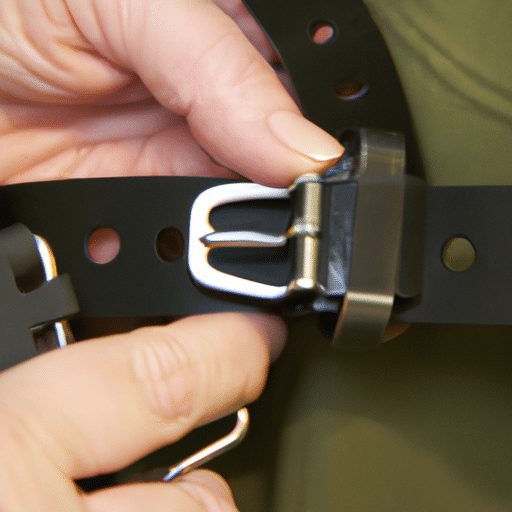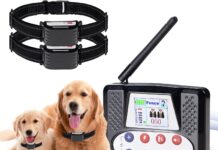Finding the right tightness for your dog’s training collar can be a bit of a puzzle, but fear not, we’ve got some helpful tips to make the process a breeze! Ensuring that the collar is neither too loose nor too tight is crucial for your pup’s comfort and safety during training sessions. In this article, we will outline some simple steps to guide you in finding that sweet spot where your dog feels comfortable and secure, allowing you both to focus on mastering those training goals with ease. Let’s get started!
Factors to Consider
When it comes to finding the right tightness for your dog’s training collar, there are several factors that you need to take into consideration. These factors include your dog’s size and breed, the type of training collar you are using, your training objectives, and the comfort and safety of your furry friend.
Dog’s Size and Breed
The size and breed of your dog play a crucial role in determining the tightness of their training collar. Smaller dogs may require a looser fit, while larger dogs may need a tighter fit to ensure effectiveness. Additionally, different breeds have varying neck sizes and shapes, so it’s important to choose a collar that fits your dog’s specific breed.
Type of Training Collar
There are various types of training collars available, each with its own unique features and functions. The type of collar you choose will influence how tight or loose it needs to be. For example, a martingale collar should fit snugly around your dog’s neck, while a head collar may require a looser fit for comfort.
Training Objectives
Your training objectives also play a role in determining the right tightness for your dog’s collar. If you are using the collar for obedience training or to correct behavioral issues, a tighter fit may be necessary. However, if you are using the collar for basic leash training or walking, a looser fit may be more appropriate.
Comfort and Safety
Comfort and safety should always be a priority when choosing the tightness of your dog’s training collar. It’s essential to ensure that the collar is not too tight to cause discomfort or restrict your dog’s breathing. A well-fitted collar should be snug but not constricting, allowing your dog to move their head and breathe comfortably.
Determining the Right Tightness
Once you have considered the factors mentioned above, there are several methods you can use to determine the right tightness for your dog’s training collar. These methods involve checking for the two-finger rule, ensuring a proper fit, observing your dog’s behavior, and regularly adjusting and monitoring the collar.
Check for Two-Finger Rule
The two-finger rule is a widely used guideline for determining the tightness of a dog’s collar. You should be able to fit two fingers comfortably between the collar and your dog’s neck. This provides a general indication of whether the collar is too loose or too tight.
Ensure Proper Fit
In addition to the two-finger rule, it’s important to ensure that the collar is properly fitted around your dog’s neck. The collar should be snug enough that it won’t slip off, but loose enough that it won’t cause discomfort or restrict movement. It’s crucial to regularly check and readjust the collar to maintain the proper fit as your dog grows.
Observe Dog’s Behavior
Your dog’s behavior can also give you valuable insights into whether the collar is too tight or too loose. If your dog is constantly scratching at their collar, rubbing their neck on furniture, or displaying signs of discomfort, it may be an indication that the collar needs to be adjusted. On the other hand, if the collar is too loose, your dog may be able to slip out of it or pull excessively during walks.
Regular Adjustment and Monitoring
As your dog grows, their collar may need to be adjusted to ensure the right tightness. Puppies, in particular, will outgrow their collars quickly, so it’s important to check and adjust the collar regularly. Additionally, it’s essential to monitor your dog’s behavior and physical comfort to ensure that the collar remains properly fitted at all times.
Factors Affecting Tightness
Several factors can affect the tightness of your dog’s training collar, including neck anatomy, collar material, collar position, and training techniques. These factors should be taken into consideration to ensure the collar fits securely and comfortably.
Neck Anatomy
Every dog has a unique neck anatomy, which can affect how tight or loose their collar should be. Some dogs may have wider necks, while others may have narrower ones. Additionally, certain breeds may have thicker necks or more prominent neck structures. It’s important to consider your dog’s individual anatomy when determining the right tightness for their collar.
Collar Material
The material of the training collar can also impact how tight or loose it should be. Some materials, such as nylon, may stretch over time, requiring regular adjustment. On the other hand, leather collars tend to maintain their shape and fit more consistently. It’s important to choose a collar material that is durable, comfortable, and suitable for your dog’s needs.
Collar Position
The position of the training collar on your dog’s neck is another factor to consider. Some collars, like martingale collars, should sit high on the neck, while others, like head collars, should sit lower. The position of the collar can affect both the fit and the effectiveness of training. It’s essential to follow the manufacturer’s instructions and adjust the collar to the correct position for optimal results.
Training Techniques
Different training techniques may require different levels of collar tightness. For example, if you are using the collar for leash corrections, a tighter fit may be necessary to effectively redirect your dog’s behavior. However, positive reinforcement training methods may require a looser fit to ensure comfort and build trust. Consider the training techniques you are using and adjust the collar tightness accordingly.
Measuring the Right Collar Size
To ensure the right tightness for your dog’s training collar, it’s important to measure their neck properly. This can be done using a soft tape measure, a piece of string, or by consulting with a professional.
Using a Soft Tape Measure
Using a soft tape measure is one of the most accurate ways to measure your dog’s neck for a collar. Place the tape measure around the base of your dog’s neck, where the collar will sit. Make sure it is snug but not tight. Take note of the measurement, as this will help you select the appropriate collar size.
Using a Piece of String
If you don’t have a soft tape measure, you can use a piece of string to measure your dog’s neck. Wrap the string around the base of your dog’s neck, mark the point where it overlaps, and then measure the length of the string with a ruler. This measurement can serve as a guide when choosing the right collar size.
Consulting with a Professional
If you’re unsure about measuring your dog’s neck or selecting the right collar size, it’s always a good idea to consult with a professional, such as a veterinarian or a dog trainer. They can provide expert guidance and assistance in finding the perfect fit for your dog’s training collar.
Types of Training Collars
There are various types of training collars available, each designed for different training purposes and dog breeds. Understanding the different types can help you choose the right collar for your dog’s specific needs.
Martingale Collar
A martingale collar, also known as a limited-slip collar, is a popular choice for training dogs that tend to pull on the leash. It features a loop that tightens when the dog pulls, applying gentle pressure to discourage pulling. These collars should fit snugly, with enough room for the dog’s head to comfortably pass through but not slip off.
Prong Collar
A prong collar, also known as a pinch collar, is designed to provide correction for dogs that exhibit more challenging behaviors, such as aggression or excessive pulling. It consists of interlocking metal links with prongs that press into the dog’s neck when tension is applied. The collar should fit snugly, allowing the prongs to make contact without causing discomfort or injury.
Head Collar
A head collar, often referred to as a gentle leader or a halti, is designed to give you more control over your dog’s head and muzzle. It works by redirecting your dog’s attention and steering their movements. Head collars should fit securely around the dog’s nose and behind the ears, ensuring that it won’t slip off or cause discomfort.
Remote Training Collar
Remote training collars, also known as electronic collars or e-collars, are used for remote obedience training and behavior modification. These collars deliver a stimulation or vibration signal to the dog, helping to reinforce commands and discourage unwanted behavior. It’s important to select a remote training collar that fits securely and comfortably, allowing for effective communication between you and your dog.
Importance of Proper Tightness
Ensuring the proper tightness of your dog’s training collar is essential for several reasons. It affects the effectiveness of training, helps avoid injuries and discomfort, prevents collar-related issues, and contributes to building trust and a strong bond with your dog.
Effectiveness of Training
The tightness of the training collar plays a significant role in its effectiveness. If the collar is too loose, it may not provide the necessary feedback to redirect or correct your dog’s behavior. Conversely, if the collar is too tight, it may cause discomfort or pain, leading to negative associations with training. Finding the right tightness ensures that the collar is effective in communicating with your dog and achieving desired training outcomes.
Avoiding Injuries and Discomfort
An ill-fitting collar can cause injuries and discomfort for your dog. If the collar is too tight, it can rub against their skin, causing irritation, chafing, or even cuts. Tight collars can also restrict your dog’s breathing and movement, leading to discomfort and potential injuries. By ensuring the proper tightness, you can minimize the risk of these issues and keep your dog safe and comfortable during training sessions.
Preventing Collar-related Issues
Collar-related issues can arise when the collar is not properly fitted. Dogs can escape from loose collars or get their jaws stuck in collars that are too tight. Additionally, some dogs may develop negative associations with their collar if it is uncomfortable or causes pain. Choosing the right tightness helps prevent these collar-related issues and ensures a positive experience for your dog.
Building Trust and Bond
Properly fitting and adjusting your dog’s training collar helps build trust and strengthen the bond between you and your furry companion. When your dog is comfortable and feels secure in their collar, they are more likely to trust your guidance during training sessions. By prioritizing your dog’s comfort and safety, you create a positive training environment that fosters a deeper connection and trust between you and your dog.
Signs of an Ill-Fitting Collar
It’s important to recognize the signs of an ill-fitting collar to ensure the ongoing comfort and safety of your dog. If you notice any of these signs, it may be an indication that the collar needs adjustment.
Indentations or Marks on the Skin
An ill-fitting collar can leave indentations or marks on your dog’s skin. These marks may be red, irritated, or even raw. If you notice any visible signs of pressure or rubbing on your dog’s neck, it’s important to adjust the collar immediately.
Choking or Gagging Sounds
When a collar is too tight, it can put pressure on your dog’s windpipe, causing choking or gagging sounds. If you observe your dog struggling to breathe or making unusual noises while wearing the collar, it’s a clear sign that the collar needs to be loosened.
Excessive Scratching or Rubbing
If your dog is constantly scratching at their collar or rubbing their neck on furniture or the ground, it may indicate that the collar is causing discomfort or irritation. Pay attention to any excessive scratching or rubbing behavior and adjust the collar accordingly to relieve discomfort.
Reluctance to Wear the Collar
A dog that shows reluctance or resistance to wearing their collar may be indicating that it is uncomfortable or causing them distress. This could manifest as the dog actively avoiding or pulling away when trying to put on the collar. If your dog consistently shows reluctance, it’s crucial to evaluate the fit and make the necessary adjustments.
Tools to Assist with Sizing
To ensure the right tightness of your dog’s training collar, there are various tools available to assist you in selecting the correct size. These tools can provide valuable guidance and ensure a proper fit for your furry friend.
Size Guides
Most reputable manufacturers include size guides with their training collars. These guides provide measurements and recommendations based on the breed, size, and weight of your dog. By referring to these size guides, you can choose the collar size that is likely to fit your dog best.
Online Collar Sizing Tools
Many online retailers and pet supply websites offer collar sizing tools. These interactive tools typically require information such as your dog’s breed, weight, and neck circumference. By inputting these details, the tool provides recommendations on the appropriate collar size for your dog.
Professional Assistance
If you’re uncertain about finding the right tightness for your dog’s training collar, it’s always a good idea to seek professional assistance. A veterinarian or a dog trainer can provide personalized advice and guidance, taking into account your dog’s individual needs and training goals. They can help you choose the right collar size and ensure a comfortable fit for your furry companion.
Consulting a Professional Trainer
Consulting a professional dog trainer can be incredibly helpful when it comes to selecting the right tightness for your dog’s training collar. They can provide expert advice, personalized guidance, and customized training plans tailored to your dog’s specific needs.
Expert Advice and Guidance
Professional trainers have extensive knowledge and experience in training dogs of all breeds and sizes. They can provide valuable advice and guidance when it comes to selecting and fitting the right training collar for your dog. With their expertise, you can ensure the collar’s tightness is appropriate for the training techniques you will be utilizing.
Customized Training Plans
Professional trainers can create customized training plans that take into account your dog’s unique personality, temperament, and training goals. They can recommend the most suitable collar type and tightness based on your dog’s specific needs. By working with a professional trainer, you can optimize your training efforts and achieve the desired results.
Collar Usage Tips
In addition to collar selection and tightness guidance, professional trainers can offer valuable tips and techniques for using the training collar effectively. They can teach you proper leash handling, timing of corrections, and communication skills to ensure successful training sessions. Collaborating with a trainer can greatly enhance your training journey and improve your relationship with your dog.
Avoiding Common Mistakes
To ensure the right tightness for your dog’s training collar, it’s important to avoid common mistakes that can compromise your dog’s comfort, safety, and overall training experience.
Using Tightness as a Form of Punishment
Using a tight collar as a form of punishment can be harmful and counterproductive. Tightening the collar excessively in an attempt to restrict your dog’s behavior or inflict pain can cause physical and emotional harm. Training should be based on positive reinforcement and trust-building, rather than using the collar as a punishment tool.
Neglecting Regular Check-ups
Once you have found the right tightness for your dog’s training collar, it’s important to regularly check and readjust the collar as needed. Dogs grow, gain or lose weight, and their collar size may change over time. Neglecting regular check-ups can result in an ill-fitting collar, discomfort, and potential complications.
Ignoring the Dog’s Feedback
Your dog’s comfort and feedback should always be taken into consideration when determining the tightness of their training collar. Dogs communicate through their behavior, body language, and vocalizations. Ignoring signs of discomfort or irritation can lead to unnecessary stress or injuries. It’s important to be attentive and responsive to your dog’s needs during training sessions.
Choosing Inappropriate Collar Type
Each type of training collar serves a specific purpose and requires a different level of tightness. Choosing an inappropriate collar type can lead to ineffective training and discomfort for your dog. It’s important to select the collar type that aligns with your training objectives and your dog’s specific needs. Consulting with a professional trainer can help you make an informed decision.
In conclusion, finding the right tightness for your dog’s training collar is crucial for effective and safe training. Considering factors such as your dog’s size and breed, the type of training collar, your training objectives, and your dog’s comfort and safety will help guide you in making the appropriate collar adjustments. By using methods like checking for the two-finger rule, ensuring a proper fit, observing your dog’s behavior, and regularly adjusting and monitoring the collar, you can ensure a snug and comfortable fit. Recognizing the signs of an ill-fitting collar and utilizing tools like size guides and professional assistance will further assist you in finding the perfect size. It’s essential to prioritize the comfort, safety, and trust-building aspects of your dog’s training collar to create a positive and effective training experience. Avoiding common mistakes, such as using tightness as a form of punishment or neglecting regular check-ups, will help maintain the proper fit and prevent potential issues. Ultimately, consulting with a professional trainer can provide expert advice, guidance, and customized training plans to optimize your training efforts and strengthen the bond between you and your furry companion.









































